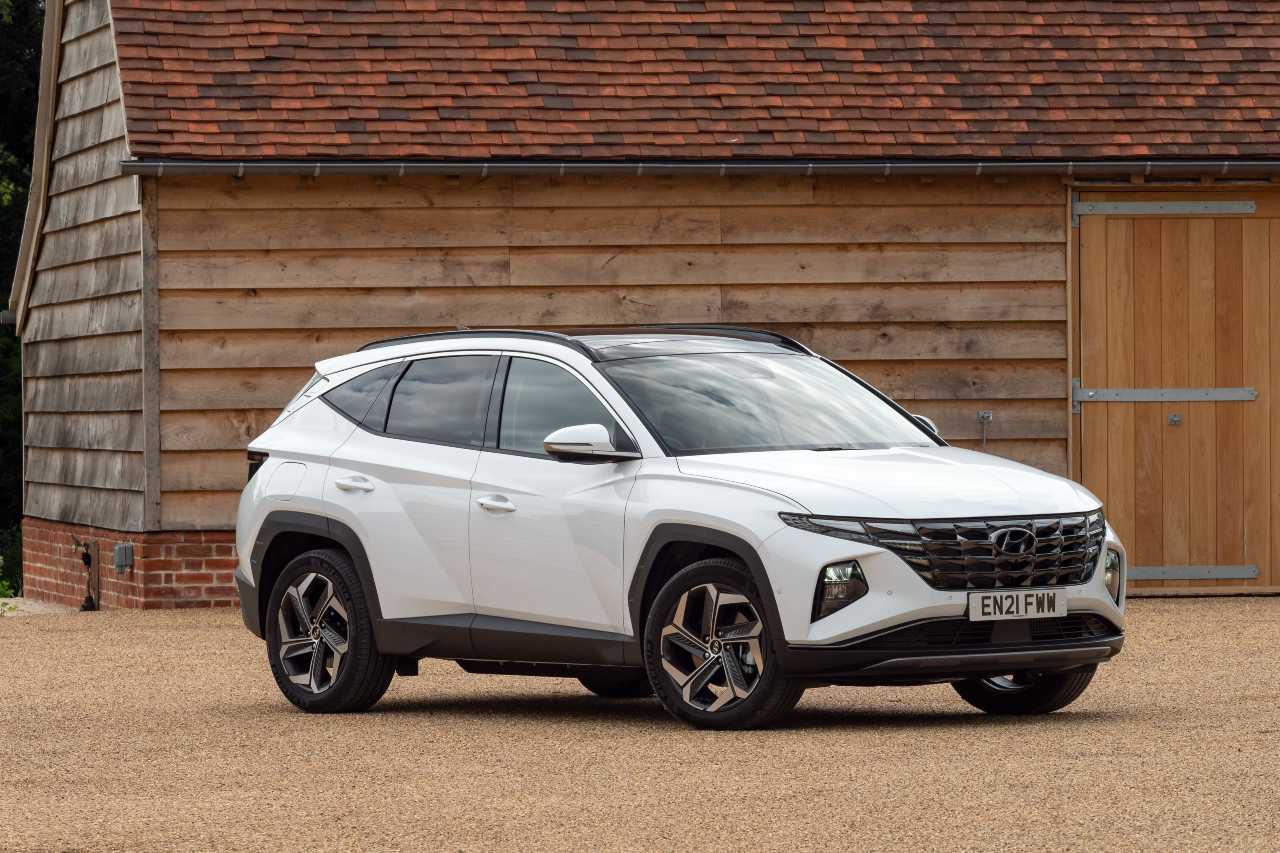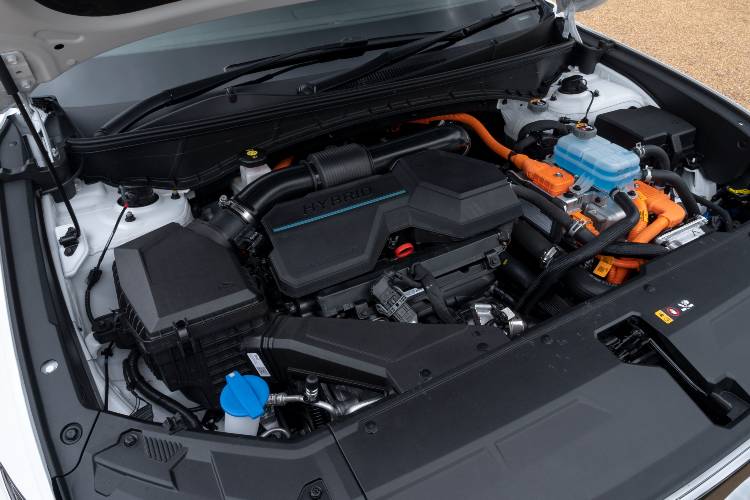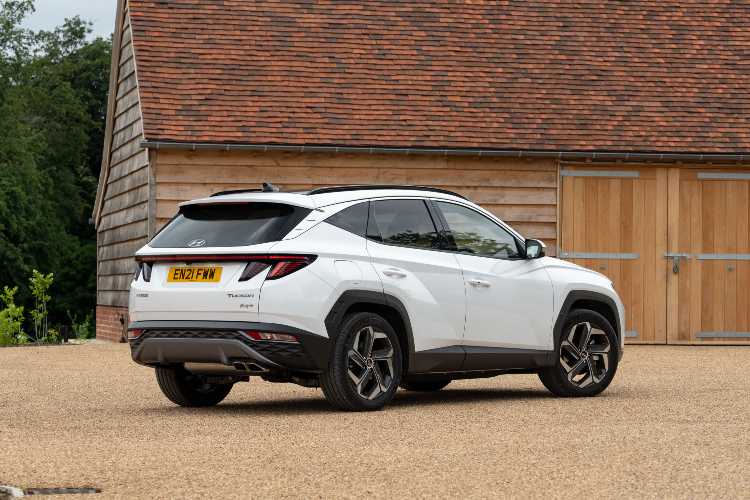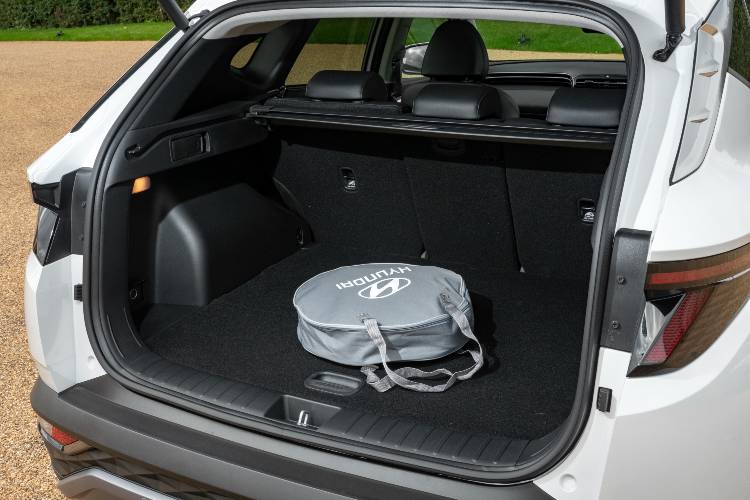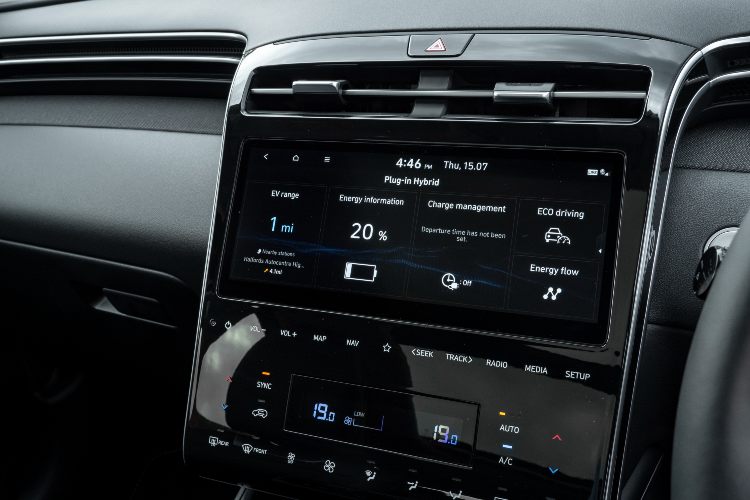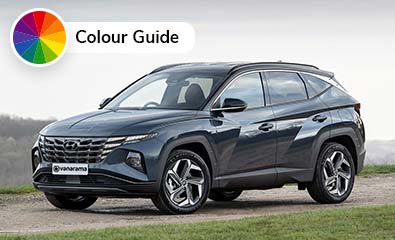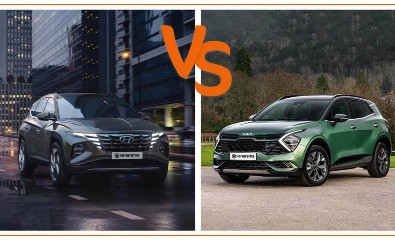What Is It?
It’s the 4th generation of the Hyundai Tucson since it first appeared in 2004, although – in this country, at least – the Mk2 model (2009-2015) wasn’t even known as the Tucson; it was sold here as the ix35. It is a 5-seat, family-friendly, midsized crossover-SUV that competes in one of the most lucrative automotive markets of all. Therefore, the Tucson’s rivals are many and varied, including (but by no means limited to) market titans like the Nissan Qashqai, Ford Kuga, Peugeot 3008 and, of course, a distantly related Korean in the form of the Kia Sportage.
However, such is the unstinting quality of the Hyundai Tucson Mk4 that it is now nibbling at the heels of premium alternatives. It's become an alternative to leasing an Audi Q3, BMW X2 or Mercedes GLA or Volvo XC40. Madness to suggest that a ‘mere’ Hyundai could possibly tempt you out of a BMW X3 lease deal? Well, maybe not. As we shall come to see, behind the Tucson’s ultra-distinctive exterior façade is one of the most accomplished, refined and downright likeable crossover-SUVs you can currently lease.
What’s Good About It?
Well, the dramatic exterior looks are hard to miss. The Tucson Mk4’s styling won’t be to all tastes, especially the huge grille complete with ‘parametric’ lights integrated into it, but if you do like the Hyundai’s daring aesthetic – and we will happily say that, here at Vanarama, we’re big, big fans of its bodywork – then you’ll really fall for this SUV in a big way. The Tucson looks like no other car and you can pick them out a mile away at night, thanks to that oh-so-idiosyncratic light signature at the front… oh, and the full-width, ‘fanged’ strip at the rear, for that matter. It's available in 11 paint colours, detailed in our Hyundai Tucson colour guide.
Adventurous exterior styling, however, clothes an interior that is vastly improved from the one found in the Mk3 (2015-2021) predecessor. We always liked the Tucson Mk3, as a simple, no-nonsense, family crossover-SUV, but its cabin always felt a touch plain and lacklustre in the face of more prestigious European opposition. No such accusation could be levelled at the Mk4’s passenger compartment. A neat design line which loops around the door cards and dashboard (encircling the cluster) forms the frame of the infotainment screen and centre stack, and gives real definition and a classy ambience to the front driver- and passenger-seat positions. Furthermore, the quality of all the materials you touch is near-faultless, every model comes with twin 10.25-inch digital displays (for the driving cluster and main infotainment screens) and the ergonomics are spot on. It’s a majestic interior, in truth.
What Could Be Better?
Perhaps the only reasonable criticism of the Hyundai Tucson Mk4 is that it doesn’t have a lot of choice in the engine department. Technically, there’s only 1 – a 1.6-litre T-GDi turbocharged 4-cylinder petrol. Now, to be fair to Hyundai, this comes in a variety of guises, including a petrol model, and a strong selection of hybrid car versions including 48-volt mild hybrids (MHEVs), a full-on Hybrid (HEV) and then a Plug-In Hybrid (PHEV, which is what we’re testing here).
There are also 3 gearboxes, with a 6-speed manual offered on the 150hp petrol and MHEV models, a 7-speed DCT provided as an option on the 150hp MHEV and as the only transmission on the 180hp MHEV, and then a 6-speed traditional torque-converter automatic for the HEV and PHEV variants. Oh, and 2 forms of traction, with the 180hp MHEV and the PHEV having 4-wheel drive, when every other Tucson sends power to the front axle only.
But if you’re wanting a turbodiesel engine, or an all-electric model, or something with bigger swept capacity for towing requirements, or maybe just something with greater than (or fewer than, if that’s your poison) 4 cylinders, the Tucson’s powertrain range is going to disappoint you.
What’s It Like To Drive?
Mark drove the HEV in his video review, so here we’re testing what is the flagship of the range, the Tucson Plug-In Hybrid in Ultimate + Tech Pack specification. Now, while the PHEV has more power than any other model – 265hp from its combined petrol-electric resources, when the next-nearest, the HEV, can only summon up 230hp – it doesn’t have a superior torque figure; its 350Nm its more than any of the MHEVs and the solitary petrol model too, but only a match for the HEV. And thus, due to the PHEV’s additional weight courtesy of both its increased electrical running gear/bigger battery and its 4-wheel-drive system, it’s actually 6/10ths of a second slower to 62mph from a standstill than the HEV – at 8.6 seconds, plays 8 seconds dead for the Hybrid.
However, the PHEV fights back courtesy of up to 38 miles of zero-emission running on its 13.8kWh lithium-ion battery, while it can also boast some outrageous economy and CO2 numbers (which we’ll come onto in the costs section) as well. It is also the most expensive version of the Tucson model-for-model, being the only variant of Hyundai’s SUV with a basic (pre-options) list price of more than £40,000 if you spec it in the halo Ultimate trim like our test car. That translates into the monthly leasing costs with Vanarama, where the PHEV is the dearest, although – again – we’ll deal with those in the costs section.
Luckily, it is quite magnificent to drive. Admittedly, the Tucson is not going to tempt you out of some of the sharper-handling vehicles in this sector, like SEAT’s Ateca, the Ford Kuga and Peugeot’s surprisingly enjoyable 3008, but it is by no means bad in this department either – body roll, while present, is well controlled and the steering has nice, clean responses to it, albeit not a huge amount of feel. The PHEV’s 4WD system does bring significant traction advantages, especially when the SUV is already rolling or is driving in poor weather conditions, and so while we wouldn’t say the Tucson is exciting to drive, it is perfectly capable in the corners and on quieter, twistier roads. The 6-speed auto is also a peach, although the attendant 1.6-litre engine gets a tad noisy if you push it hard.
Yet the Hyundai truly shines for refinement and comfort. That weight penalty that all PHEVs must carry, not just the Tucson Plug-In, is present here – other models of the Hyundai weigh between 1.4 and 1.7 tonnes, but the PHEV is more than 1.8 tonnes at its lightest and a whopping 1924kg at its heftiest. Such weight normally not only spoils the handling, but sometimes the ride too – and this counts doubly when the vehicle is on 19-inch alloy wheels as well.
Not the Tucson, though. It rides beautifully, smothering out road imperfections with a grace and dignity that’s befitting of machines several classes up. Whether ambling about town on electric power alone or cruising along a motorway at the national speed limit, the Tucson is simply supremely comfortable. It’s even good at suppressing wind and tyre noise, too, while placing it on the roads is incredibly easy. Furthermore, the advanced driver assist systems (ADAS) it has bleed away any stresses of long-distance motoring before they can even affect your mood. In short, the Tucson PHEV is genuinely excellent to drive in a wide variety of motoring circumstances.
How Practical Is It?
Well, for passenger space and interior storage compartments, there are no complaints from these quarters. The centre-rear seat does have a slightly raised floor, but Hyundai has kept this low and it’s not hard to imagine an adult sitting there in decent levels of comfort. Elsewhere, big door pockets, a couple of neatly integrated cupholders in the transmission tunnel and other assorted cubbies keep odds-and-ends safely stashed while you’re on the move.
Which then brings us onto boot space. As a family of cars, the Tucson has no fewer than 4 different boot capacities, depending on which model you go for. The most practical here is the petrol, with a ginormous 620-litre boot with all seats in play – easily one of the biggest cargo areas in this class – and 1799 litres with the rear row folded away. The HEV is next, with 616-1795 litres, then the MHEVs follow with 577-1756. Finally, this PHEV model is the least capacious, due to the placement of various electric-running ancillaries under the boot floor. However, even 558-1737 litres of space back here places the Tucson Plug-In Hybrid in the upper echelons of boot capacity when compared to rivals, so this is one deeply practical family machine.
How Much Will It Cost Me?
We lease the Hyundai Tucson from less than £300pcm for the basic T-GDi 150hp petrol in SE Connect specification, although most models are in the £300-£400pcm bracket. The PHEV, however, is the most pricey, costing almost £400pcm in all formats and up to £450 if you go for an Ultimate with options like our test vehicle.
That said, an official 201.8mpg figure and 31g/km CO2 make this the most efficient and tax-busting Tucson of the lot, while the 38-mile EV-running claim is notably high for a PHEV. Word of warning, though: as with all plug-in hybrids, getting 100mpg-plus requires regular (and we do mean regular) charging cycles plus the majority of your driving to be conducted on electric power alone, meaning you don’t want to be going much more than 40-80 miles a day (depending on where and when you can charge it). We exhausted the battery pack on our tester, and as a result a 195-mile motorways-and-A-roads run from Hampshire to Cheshire saw us nudging just past 40mpg for the trip – against an overall weekly average of 41mpg. Not bad, but nowhere near 201.8mpg, if that’s what you’re primarily after.
For your money, though, you get an awful lot of equipment. Tucson specifications begin with the SE Connect, then rise up 2 distinct arms: if you want sporty looks, you need the N Line, which is superseded by the N Line S; while if you want to major on the luxury aspects of the car, which we’d advocate given its overall comfort levels, then the steps up are Premium and finally Ultimate. You can think of N Line and Premium as roughly analogous, as well as N Line S and Ultimate, although there are key spec differences between them.
SE Connect cars are well stocked from the off. Both the 10.25-inch Supervision Instrument Cluster and satnav-enabled 10.25-inch infotainment (with Apple CarPlay and Android Auto) are standard fit, as are 17-inch alloy wheels, cruise control, Drive Mode Select, dual-zone climate control, High Beam Assist, rear parking sensors and also a reversing camera, among much more.
The N Line adds a significant exterior and interior design pack, plus LED headlights, 19-inch alloys, keyless entry and go, a wireless smartphone charging pad, alloy pedals, ambient interior lighting, heated front seats, suede and leather upholstery, and privacy glass. N Line S enhances that grade with a Krell Premium Audio system, a panoramic glass sunroof, Smart Adaptive Speed Control (adaptive cruise control, on DCT and autos only), a powered tailgate, 3-zone climate control, a heated steering wheel and enhanced ADAS technologies.
Over on the other side of the spec tree, the Premium includes 18-inch alloys (19s on the HEV and PHEV cars), enhanced ADAS, the Krell audio, heated front seats and steering wheel, adaptive cruise, ambient interior lighting, the wireless smartphone charging pad, and front and rear parking sensors to the SE Connect’s roster of goodies. The Ultimate, though, really does load in the luxuries, including electrically adjustable front seats, heated rear outer seats, ventilation functionality to the front seats, leather upholstery, a hands-free powered tailgate, the panoramic tilt-and-slide roof, and sundry other ADAS items. It is, as the trade likes to say, ‘fully loaded’.
Anything Else I Should Know?
Our test Tucson Plug-In Hybrid had the optional Tech Pack added. This further ups the toy count with Electronic Control Suspension (ECS, adjustable damping in essence), a 360-degree Around View Monitor, the brilliant Blind Spot View Monitor (backwards-facing camera feeds from the door mirrors come up in the left or right dials in the cluster, according to which way you’re indicating), the Remote Smart Park Assist (park the car using only the key fob to control it), and Parking Collision Avoidance Assist (PCA). This last feature is specific to the PHEV only.
What Are The Alternatives To The Tucson?
Kia Sportage Leasing
Having evolved into its 5th generation, the Kia is just as bold to look at and just as brilliant to live with as the Hyundai. You can see how the Sportage and Tucson compare in our dedicated article.
Nissan Qashqai Leasing
The sales heavyweight in this sector will not have things all its own way going forward, even if the Mk3 Qashqai is very good. See how the Qashqai and Tucson compare in our vs article.
Peugeot 3008 Leasing
Sharp chassis, attractive styling and an unusual interior mark out this French family chariot, which has 2 PHEV options in its range.
The Vanarama Verdict: 9/10
“The Tucson looks like no other car and you can pick them out a mile away at night… It rides beautifully, smothering out road imperfections with a grace and dignity that’s befitting of machines several classes up.”
3 Things To Remember About The Hyundai Tucson PHEV:
-
Feels thoroughly high quality in so many different regards
-
Striking exterior appearance
-
Comes loaded with kit
For more articles, you can check out our car features and guides section. Or if you're looking for a brand new vehicle, we've got a huge range of cars to lease at unbeatable prices.

